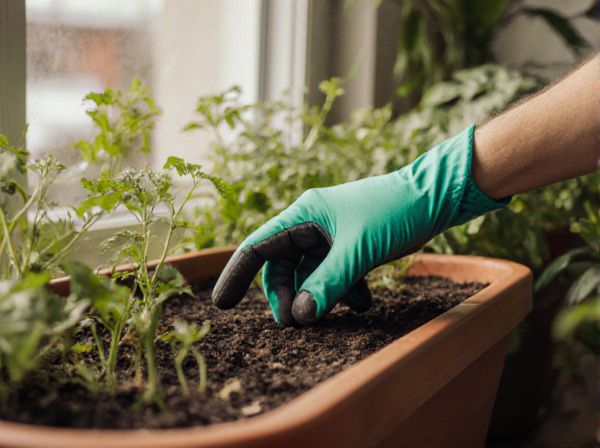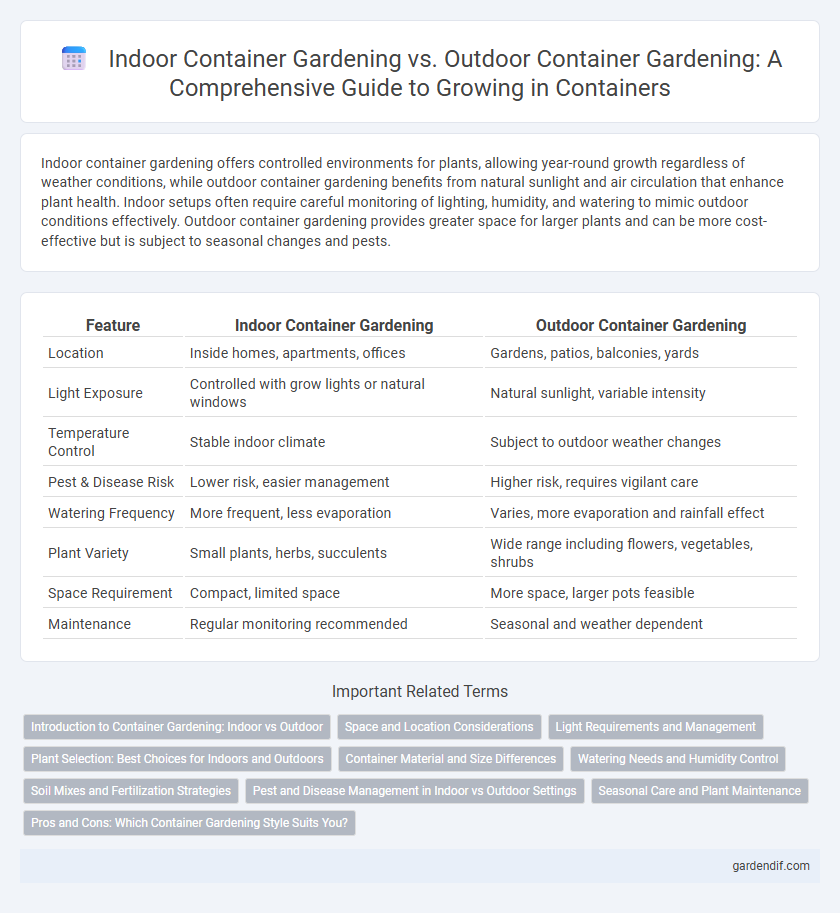
Indoor container gardening vs outdoor container gardening Illustration
Indoor container gardening offers controlled environments for plants, allowing year-round growth regardless of weather conditions, while outdoor container gardening benefits from natural sunlight and air circulation that enhance plant health. Indoor setups often require careful monitoring of lighting, humidity, and watering to mimic outdoor conditions effectively. Outdoor container gardening provides greater space for larger plants and can be more cost-effective but is subject to seasonal changes and pests.
Table of Comparison
| Feature | Indoor Container Gardening | Outdoor Container Gardening |
|---|---|---|
| Location | Inside homes, apartments, offices | Gardens, patios, balconies, yards |
| Light Exposure | Controlled with grow lights or natural windows | Natural sunlight, variable intensity |
| Temperature Control | Stable indoor climate | Subject to outdoor weather changes |
| Pest & Disease Risk | Lower risk, easier management | Higher risk, requires vigilant care |
| Watering Frequency | More frequent, less evaporation | Varies, more evaporation and rainfall effect |
| Plant Variety | Small plants, herbs, succulents | Wide range including flowers, vegetables, shrubs |
| Space Requirement | Compact, limited space | More space, larger pots feasible |
| Maintenance | Regular monitoring recommended | Seasonal and weather dependent |
Introduction to Container Gardening: Indoor vs Outdoor
Indoor container gardening offers controlled environments ideal for growing herbs, houseplants, and small vegetables, utilizing limited space and providing year-round cultivation. Outdoor container gardening leverages natural sunlight and ventilation for a wider variety of plants, including flowers, shrubs, and larger vegetables, adapting to seasonal changes. Both methods enhance urban gardening possibilities, increase plant accessibility, and address space limitations effectively.
Space and Location Considerations
Indoor container gardening offers a controlled environment ideal for limited spaces such as apartments or balconies, enabling year-round growth regardless of weather conditions. Outdoor container gardening requires sufficient sunlight exposure and protection from extreme weather, making location critical to plant health and productivity. Efficient space utilization indoors relies on vertical arrangements and compact containers, while outdoor setups can accommodate larger pots and varied plant groupings.
Light Requirements and Management
Indoor container gardening requires careful management of artificial light sources such as LED grow lights or fluorescent lamps to ensure plants receive 12-16 hours of light daily, crucial for photosynthesis and growth. Outdoor container gardening depends on natural sunlight, demanding selection of placement with optimal light exposure, typically 6-8 hours of direct sun for most flowering and vegetable plants. Proper light intensity and duration directly influence plant health, flowering, and productivity in both indoor and outdoor container gardening settings.
Plant Selection: Best Choices for Indoors and Outdoors
Indoor container gardening favors plants like pothos, spider plants, and peace lilies, which thrive in low to moderate light and controlled temperature conditions. Outdoor container gardening supports sun-loving plants such as tomatoes, petunias, and herbs, benefiting from natural sunlight and air circulation. Selecting plants based on specific light, temperature, and humidity requirements ensures optimal growth and health for both indoor and outdoor container gardens.
Container Material and Size Differences
Indoor container gardening typically favors lightweight materials such as plastic, ceramic, or fiberglass to facilitate easy movement and reduce strain on surfaces, with containers often smaller in size to fit limited indoor spaces. Outdoor container gardening demands durable materials like terra cotta, concrete, or metal that can withstand varying weather conditions, often requiring larger sizes to accommodate extensive root systems and provide stability against wind. Material choice impacts water retention and insulation properties, while container size influences plant growth potential and maintenance frequency.
Watering Needs and Humidity Control
Indoor container gardening demands consistent monitoring of soil moisture and humidity levels due to limited air circulation and evaporation, often requiring more frequent but moderate watering to prevent root rot. Outdoor container gardening benefits from natural rainfall and airflow, reducing the need for frequent watering, but requires vigilance during dry spells to maintain adequate soil moisture. Proper humidity control in indoor setups can be managed with humidifiers or misting, while outdoor containers rely on environmental conditions, affecting transpiration rates and overall plant health.
Soil Mixes and Fertilization Strategies
Indoor container gardening requires soil mixes with excellent drainage and aeration, often incorporating components like perlite, peat moss, and vermiculite to prevent root rot and retain moisture. Outdoor container gardening benefits from heavier, nutrient-rich soils balanced with organic matter such as compost or aged manure to sustain plants through variable weather conditions. Fertilization strategies for indoor containers focus on frequent applications of balanced, water-soluble fertilizers, while outdoor containers typically need slow-release fertilizers combined with periodic organic amendments to enhance soil fertility.
Pest and Disease Management in Indoor vs Outdoor Settings
Indoor container gardening typically faces fewer pest and disease challenges due to controlled environmental conditions, reducing exposure to common outdoor pests like aphids, spider mites, and fungal infections. Outdoor container gardens are more susceptible to a diverse range of pests and pathogens, requiring vigilant monitoring and integrated pest management strategies such as organic pesticides and companion planting. Proper ventilation, sanitation, and regular inspection are crucial in both settings to prevent infestations and maintain plant health.
Seasonal Care and Plant Maintenance
Indoor container gardening requires consistent temperature control and protection from pests, with regular watering schedules adjusted for lower light levels. Outdoor container gardening demands seasonal attention to weather variations, frost protection in colder months, and periodic feeding to support plant growth under natural conditions. Both methods benefit from routine pruning and soil replenishment to maintain plant health and productivity throughout the growing season.
Pros and Cons: Which Container Gardening Style Suits You?
Indoor container gardening allows precise control over temperature, humidity, and light, ideal for year-round cultivation of herbs and small plants, but limited by space and potential light deficiencies. Outdoor container gardening offers natural sunlight and air circulation, promoting robust plant growth and larger container options, yet exposes plants to weather fluctuations and pests. Choosing between indoor and outdoor container gardening depends on space availability, climate conditions, and plant type preferences.
Indoor container gardening vs outdoor container gardening Infographic

 gardendif.com
gardendif.com